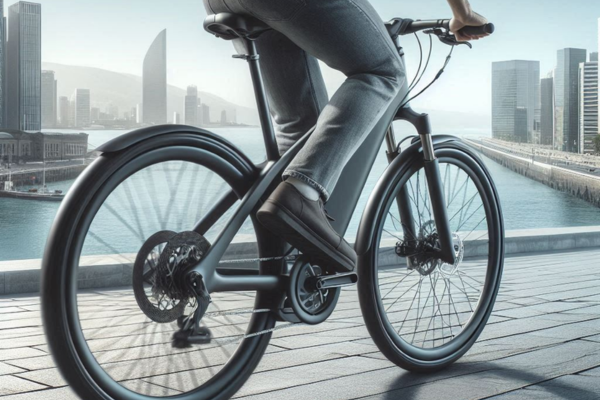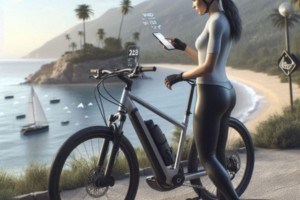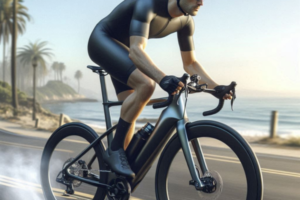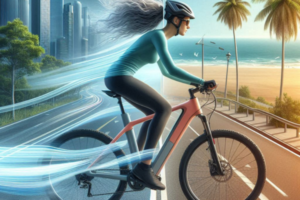Tire wind resistance electric bicycles may not be the most obvious combination of words, but for e-bike riders living in coastal cities, it’s a relationship that defines performance. When you’re riding through humid air, along breezy boardwalks or oceanfront bike lanes, your tires become more than just ground contact—they become aerodynamic actors in a constant negotiation with the wind. 🌬️🚴♀️
Most riders focus on battery size, motor wattage, or weight reduction when trying to improve range. But few realize that tires, especially in humid environments, are the first components to meet air and water resistance simultaneously. The wind doesn’t just hit the body and frame—it spins around the tire profile, pushes against treads, and reacts to pressure and deformation. If ignored, these small effects quietly drain battery power, reduce speed, and cause fatigue. 🛞💧
🌊 Why Tires Matter More in Coastal Environments
In coastal cities like Cartagena, Fort Lauderdale, or Lisbon, humidity isn’t just a seasonal nuisance—it’s an everyday reality. Moist air clings to your wheels and sidewalls. If your tires are wide, knobby, or underinflated, the air grabs onto their surface, disrupting laminar flow and creating micro-drag. Combined with salty air and often uneven surfaces, tire design can either amplify or smoothen your interaction with wind. 🌫️⚙️
Electric bicycles, unlike traditional road bikes, often come with wider tires to support heavier frames, panniers, or passengers. These wider tires increase your frontal area—the surface that “catches” the wind. In humid air, that frontal area feels stickier and slower. Just like cars are tested in wind tunnels with various tire shapes and rim configurations, e-bikes need tire setups that don’t fight the air—they need to glide through it. 🌬️🛠️
📉 The Science Behind Tire Wind Resistance in Electric Bicycles
Let’s break down how tires contribute to drag in humid coastal settings:
- 🔴 Wider tires create more drag by presenting a larger surface to the wind
- 🔴 Knobby treads disturb airflow and retain water, increasing micro-turbulence
- 🔴 Underinflated tires deform, increasing both rolling and aerodynamic resistance
- 🔴 Dirty or uneven tires trap moisture, road grime, and sand—magnifying friction
These factors combine to force your e-bike’s motor to work harder—even on flat terrain. Many riders believe their battery is underperforming when in reality, it’s working overtime to push through unnecessary drag caused by the tires. 🧪🔋
💬 Rider Case: “After I moved to a coastal town, my range dropped 15%. I thought the battery was failing. Turns out my off-road tires were catching air and water like sails. I swapped to slicks and instantly gained back 5 kilometers.” — Marina, Barranquilla commuter
Improving aerodynamics through tire choice doesn’t mean sacrificing safety or comfort. It means understanding that tire wind resistance electric bicycles is a measurable relationship. Just like frame geometry and posture, tire profile, tread, and pressure need to be adapted to the conditions—especially when riding through thick, wet, salty air. 🌁⚡
This understanding lays the foundation for smarter e-bike riding in coastal regions, where aerodynamic resistance adds up subtly over time. In the upcoming blocks, we’ll explore how tire width, tread design, pressure, and even rotational drag affect your ride, and what you can do to stay ahead of the wind—without fighting it. 🧭🔩
Tire wind resistance electric bicycles is a topic that blends engineering insight with practical riding experience—especially for those navigating humid, coastal cities. In these regions, where the air is heavy with moisture and breezes are frequent, tire selection becomes a subtle but powerful aerodynamic choice. 🌫️🌴
The first question many riders ask is: should I choose wider tires for comfort, or narrow tires for speed? The answer, especially in coastal environments, requires a deeper look at how different tire characteristics affect wind resistance and battery performance. Let’s start by comparing the most common e-bike tire types used in seaside urban settings. 🛞🔍
📊 Tire Types vs. Aerodynamic Efficiency in Coastal Conditions
| Tire Type | Typical Width | Aerodynamic Profile | Performance in Humid Air |
|---|---|---|---|
| Knobby Off-Road | 2.2”–4.0” | High Drag | Retains water and creates turbulence; not ideal |
| Commuter Hybrid | 1.5”–2.0” | Moderate Drag | Balanced grip and airflow; decent in humid cities |
| Urban Slick | 28mm–38mm | Low Drag | Best for airflow; sheds moisture and cuts drag |
This table highlights the trade-offs between traction, comfort, and aerodynamics. In coastal settings, where damp air surrounds the bike at every turn, the benefits of lower-drag tires quickly become apparent. 🌬️💧
🛞 Why Slick Tires Make Sense in Humid Coastal Cities
Slick or semi-slick tires reduce drag not only because of their narrower size but also because they allow air to move smoothly across the sidewalls. With no aggressive tread to disrupt the airflow, the wheel becomes a rotating cylinder rather than a wind catcher. This helps maintain laminar flow, meaning less resistance and better energy conservation—something every e-bike rider cares about. ⚡🔋
Many e-bike manufacturers are now offering urban tire profiles that mimic automotive sidewall shaping—rounded shoulders, low surface texture, and hydrophobic materials. These features, taken directly from vehicle wind-tunnel testing, allow the wheel to slice through air and moisture more efficiently, especially at speeds over 25 km/h. 🚴♂️💨
🧠 Real-World Feedback: “I used to think tires didn’t matter as long as they were new. But after I swapped to 35mm slicks on my coastal commute, my battery usage dropped noticeably. I didn’t change anything else. Just the tires.” — Rafael, e-bike delivery rider in Miami Beach
It’s this kind of insight that reminds us: optimizing tire wind resistance electric bicycles is not only about performance—it’s about control, energy, and adaptability. In environments where salt, sand, and wind constantly interact, your tires are your first aerodynamic defense. The smarter they are, the farther you go. 🌊🧭
Tire wind resistance electric bicycles is more than just a technical concept—it’s a daily challenge for riders in coastal cities. From high humidity to salt-laden breezes and wet roads, every environmental factor amplifies how your tires behave under pressure, both literally and aerodynamically. 🌀🌊
In this context, one of the most overlooked aspects is tire maintenance. Even the best-designed tire can become a source of wind drag if it’s underinflated, dirty, or misaligned. These aren’t cosmetic issues—they’re aerodynamic inefficiencies. Let’s break down the most critical points where maintenance meets wind resistance. 🔧🛞
🧼 Tire Setup and Maintenance Checklist for Coastal Conditions
- ✅ Check tire pressure weekly: Underinflated tires deform, increasing contact surface and drag. Use a digital gauge to stay within the optimal PSI for your weight and terrain.
- ✅ Inspect for tread wear: Worn or uneven treads trap moisture and disturb airflow. Replace tires that have flattened centers or scalloped edges.
- ✅ Align your wheels: Misaligned wheels increase drag and can pull your bike slightly to one side—forcing more muscular effort and motor output.
- ✅ Clean after coastal rides: Sand, salt, and road grime disrupt the smooth rotation of your tires and increase micro-resistance. A soft brush and freshwater rinse go a long way.
- ✅ Use protective sealants: Hydrophobic sprays on sidewalls help repel moisture and preserve aerodynamic integrity.
- ✅ Trim or secure valve stems and rim tape: Loose or protruding items increase turbulence at the wheel hub area.
Each of these steps takes only minutes but adds up to measurable gains in efficiency. In humid environments, where air and road conditions are rarely dry or ideal, maintenance is aerodynamic insurance. 🌧️🛠️
🔄 Tire Deformation and Its Aerodynamic Cost
When tires are underinflated—a common issue in warm, humid cities—they flatten out at the contact patch, spreading the tire’s footprint wider across the road. This not only increases rolling resistance but also exposes more surface to the wind, especially at the lower half of the wheel where wind resistance is already greatest due to rotation speed. The result? Increased battery consumption and reduced range. 🔋⚠️
Overinflation isn’t the answer either. It makes the tire harder but reduces grip, which is dangerous on slick roads. In coastal zones, the balance must be precise—firm enough to prevent drag, soft enough to maintain control. Think of it like tuning a sail: too tight, and you lose responsiveness; too loose, and you catch every gust inefficiently. 🧘♂️🌬️
💬 Rider Experience: “I thought my new tires were slow. Turns out I was running them 15 PSI below spec. Once I corrected the pressure and cleaned them regularly, I gained 2–3 extra kilometers per ride.” — Sofía, coastal commuter in Valparaíso
This is why tire wind resistance electric bicycles is not only about design—it’s about attention. Many e-bike riders upgrade their frame or motor before ever inspecting their tires. Yet these rotating components are in constant contact with wind and water, multiplying resistance every second of every ride. 💧🔄
In the next block, we’ll explore how rotational drag and environmental factors such as crosswinds and puddle spray impact tire performance—and how to build an aerodynamic tire system that’s ready for any coastal ride. 🏝️🔬
Tire wind resistance electric bicycles becomes even more complex when we introduce real-world conditions like crosswinds, road spray, and rotational drag. In coastal environments, the wind doesn’t only come from the front—it swirls, pushes, and cuts across the side of your bike. This type of airflow impacts the tires more than you might think, especially at higher speeds or during sudden gusts. 🌬️🛞
When your tires rotate, they don’t just roll forward—they spin through the air. Every part of the tire moves in a circular path, which means the leading edge is traveling faster than the rest of the bike. As a result, the front half of the wheel “slices” into the air at a greater speed, creating resistance known as rotational drag. The more tread, width, and water on that tire, the greater the drag. 🔄⚙️
🌫️ Why Rotational Drag Matters in Humid Coastal Cities
In humid areas like Santa Marta or Key West, wind is often accompanied by dampness. Wet surfaces, salty spray, and condensation coat your tires and rims, adding mass and disrupting airflow. That means your tires aren’t just pushing through wind—they’re also pushing moisture, which increases drag and requires more energy from your motor. 💧🔋
High humidity also makes road debris stickier. Sand and dust from boardwalk paths or coastal trails accumulate more easily on moist tires. This changes the rotational balance and causes micro-resistance as the wheel turns. Over time, these forces quietly reduce speed and battery life. 🏖️🧪
🌬️ Crosswinds and Tire Profile: The Hidden Threat
Larger tires, particularly those with prominent sidewalls, act like sails when struck by wind from the side. On breezy days, a tall tire sidewall can catch wind and destabilize your steering, especially on bridges, open roads, or beach paths. That instability causes riders to adjust their posture, shifting their position and increasing their own frontal drag. It’s a cascading aerodynamic loss. 🚴♂️❌
Choosing a tire with a lower profile or rounded sidewalls can help deflect crosswind pressure more efficiently. Likewise, directional tread patterns help channel airflow and reduce the risk of turbulent swirl. These subtle design features, borrowed from automotive tire engineering, are now becoming more common in high-performance e-bike tires. 🧠🛠️
💬 Rider Tip: “When I switched from 2.4” fat tires to 38mm slicks, I expected a bumpier ride—but I didn’t expect how much easier it would be to handle crosswinds. I’m faster, steadier, and my arms don’t tire out fighting wind.” — Esteban, e-bike rider in Cartagena
🛠️ Technical Solutions for Environmental Drag
- ✅ Use matte or rubberized sidewalls: These reduce glare and moisture retention, improving airflow in coastal fog.
- ✅ Clean your tires regularly: After every ride near the ocean, remove any grime or water film to maintain balance and aerodynamic shape.
- ✅ Match tire width to frame: Avoid using overly wide tires that bulge past the fork or fenders; this creates irregular airflow zones.
- ✅ Seal rim tape and valve stems: Small gaps disrupt laminar flow around the wheel hub and create hotspots of turbulence.
These technical upgrades don’t require new motors or massive investments—just intentional design and routine care. And in a humid, wind-sensitive environment, the payoff is immediate: better handling, less drag, and more confidence on every ride. 💪🌴
Understanding tire wind resistance electric bicycles is about recognizing the small resistances that stack up to create big inefficiencies. A clean, narrow, well-maintained tire doesn’t just roll better—it slices through the invisible forces of coastal riding like a pro. 🌊🔧
Tire wind resistance electric bicycles is not just a technical consideration—it’s a key part of building a smoother, more sustainable e-bike lifestyle. For riders along coastlines and in tropical cities, tires aren’t passive components—they’re aerodynamic tools that either help you glide forward or quietly hold you back. 🌬️🚴♀️
By paying attention to tire profile, pressure, maintenance, and weather adaptation, you unlock extra range, better handling, and a ride that feels lighter—even when the air is heavy with moisture. Whether you’re riding through coastal mist at dawn or battling an afternoon headwind, smart tire choices make every kilometer more efficient. ⚙️💡
❓ Frequently Asked Questions (FAQs)
Does tire choice really affect wind resistance in e-bikes?
Yes. Wider or knobby tires increase the frontal area and disrupt airflow, creating drag. Narrow, smooth tires reduce wind resistance and improve range.
What’s the ideal tire width for coastal urban riding?
A range between 28mm to 38mm offers a strong balance between comfort, grip, and aerodynamic performance—especially on paved or mixed terrain.
Should I deflate my tires slightly for wet conditions?
Lowering pressure slightly improves traction, but avoid underinflation—it increases drag and rolling resistance. Stay within the tire’s recommended PSI range.
How often should I clean my tires in humid cities?
After every ride near the coast. Moisture and salt can attract dust and debris, affecting balance, drag, and long-term durability.
Are there e-bike specific tires designed for better airflow?
Yes. Many brands now offer e-bike tires with contoured sidewalls, slick surfaces, and hydrophobic compounds to optimize both grip and wind performance.
🌟 Thought to Ride With: “We don’t ride through the air—we ride with it. The smoother our choices, the farther our journey.”
💬 Join the Coastal E-Bike Community
Every insight you gain—every tire you choose—makes you part of a growing community of smart, sustainable riders. If you’ve upgraded your tires, optimized your pressure, or found a better way to beat the wind in your city, share it. Your experience could improve someone else’s next ride. 🌎🛞
Leave a comment with your favorite tire setup. Tag us with your before-and-after drag savings. Recommend a brand that transformed your coastal commute. Or simply say hi and tell us where you ride. We’re building a movement—one optimized wheel at a time. 💙🚴♂️
📣 Community Call: What tire change made the biggest difference in your ride? Share it below—it might help someone extend their range or ride with more confidence in windy, humid weather.
Thank you for being part of this coastal riding revolution. 💙 With the right tires, the right care, and a little wind wisdom, you don’t just ride—you glide. 🌊🛞



